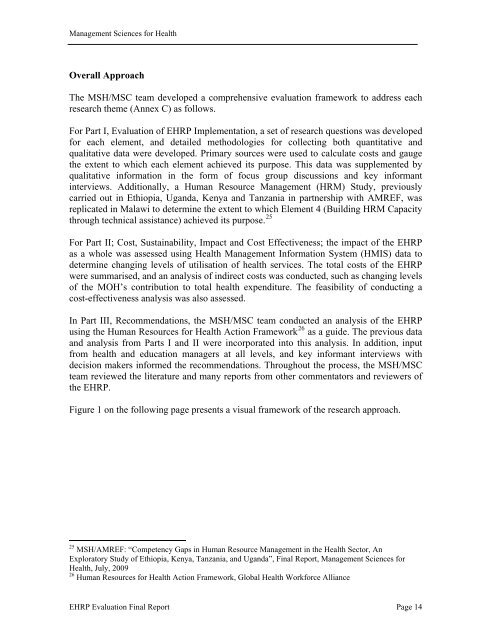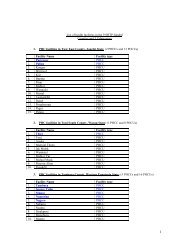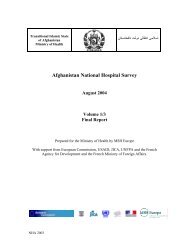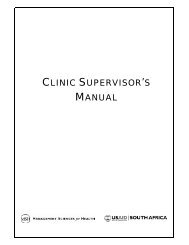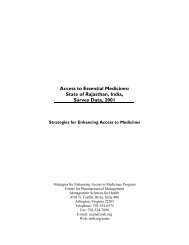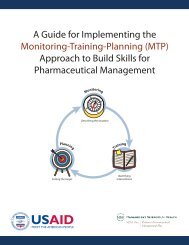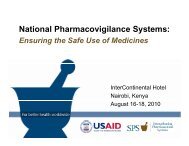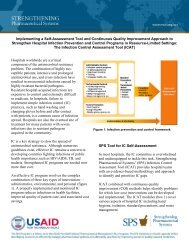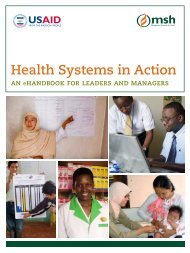Evaluation of Malawi's Emergency Human Resources Programme
Evaluation of Malawi's Emergency Human Resources Programme
Evaluation of Malawi's Emergency Human Resources Programme
Create successful ePaper yourself
Turn your PDF publications into a flip-book with our unique Google optimized e-Paper software.
Management Sciences for Health<br />
Overall Approach<br />
The MSH/MSC team developed a comprehensive evaluation framework to address each<br />
research theme (Annex C) as follows.<br />
For Part I, <strong>Evaluation</strong> <strong>of</strong> EHRP Implementation, a set <strong>of</strong> research questions was developed<br />
for each element, and detailed methodologies for collecting both quantitative and<br />
qualitative data were developed. Primary sources were used to calculate costs and gauge<br />
the extent to which each element achieved its purpose. This data was supplemented by<br />
qualitative information in the form <strong>of</strong> focus group discussions and key informant<br />
interviews. Additionally, a <strong>Human</strong> Resource Management (HRM) Study, previously<br />
carried out in Ethiopia, Uganda, Kenya and Tanzania in partnership with AMREF, was<br />
replicated in Malawi to determine the extent to which Element 4 (Building HRM Capacity<br />
through technical assistance) achieved its purpose. 25<br />
For Part II; Cost, Sustainability, Impact and Cost Effectiveness; the impact <strong>of</strong> the EHRP<br />
as a whole was assessed using Health Management Information System (HMIS) data to<br />
determine changing levels <strong>of</strong> utilisation <strong>of</strong> health services. The total costs <strong>of</strong> the EHRP<br />
were summarised, and an analysis <strong>of</strong> indirect costs was conducted, such as changing levels<br />
<strong>of</strong> the MOH’s contribution to total health expenditure. The feasibility <strong>of</strong> conducting a<br />
cost-effectiveness analysis was also assessed.<br />
In Part III, Recommendations, the MSH/MSC team conducted an analysis <strong>of</strong> the EHRP<br />
using the <strong>Human</strong> <strong>Resources</strong> for Health Action Framework 26 as a guide. The previous data<br />
and analysis from Parts I and II were incorporated into this analysis. In addition, input<br />
from health and education managers at all levels, and key informant interviews with<br />
decision makers informed the recommendations. Throughout the process, the MSH/MSC<br />
team reviewed the literature and many reports from other commentators and reviewers <strong>of</strong><br />
the EHRP.<br />
Figure 1 on the following page presents a visual framework <strong>of</strong> the research approach.<br />
25 MSH/AMREF: “Competency Gaps in <strong>Human</strong> Resource Management in the Health Sector, An<br />
Exploratory Study <strong>of</strong> Ethiopia, Kenya, Tanzania, and Uganda”, Final Report, Management Sciences for<br />
Health, July, 2009<br />
26 <strong>Human</strong> <strong>Resources</strong> for Health Action Framework, Global Health Workforce Alliance<br />
EHRP <strong>Evaluation</strong> Final Report Page 14


